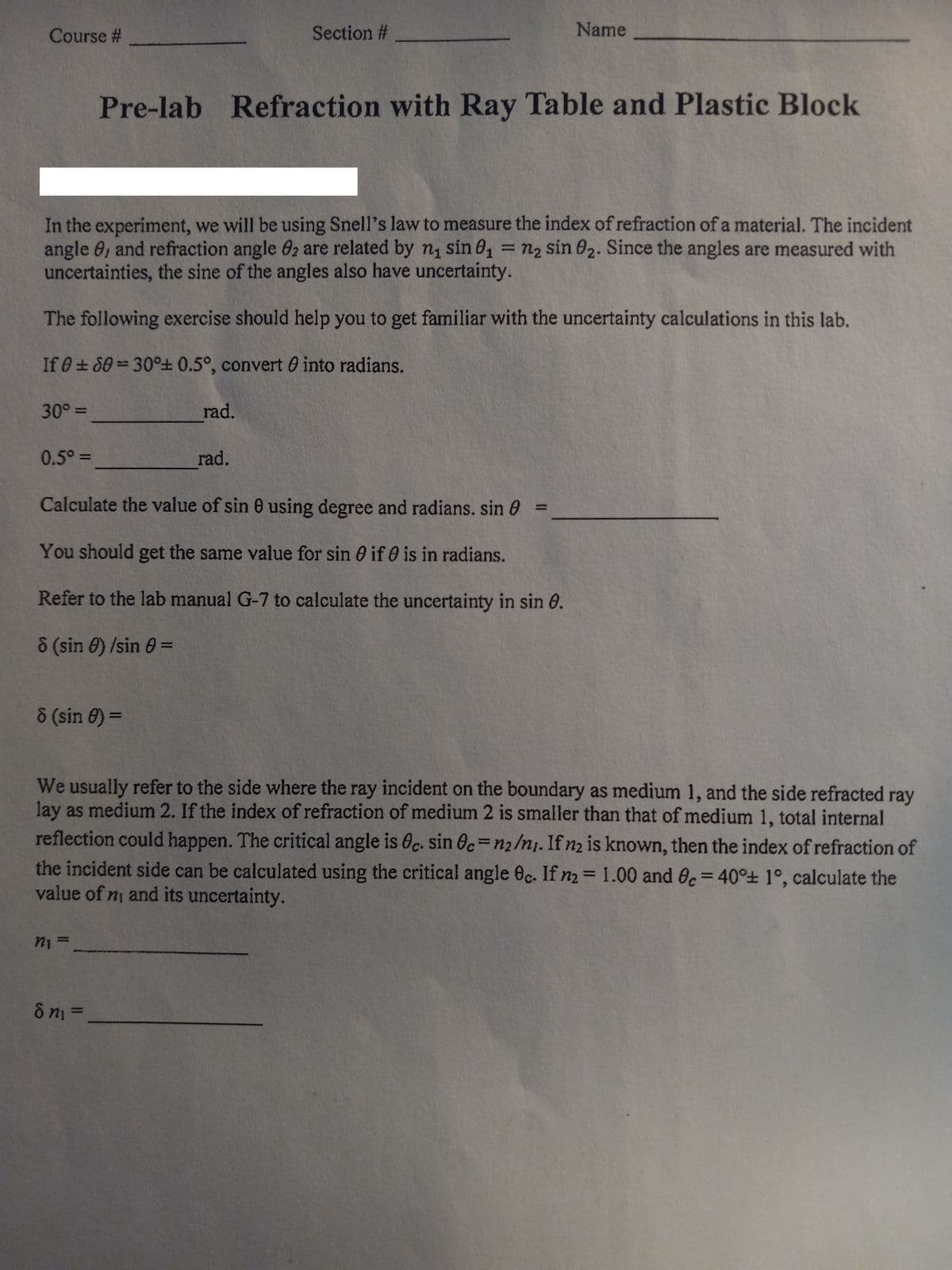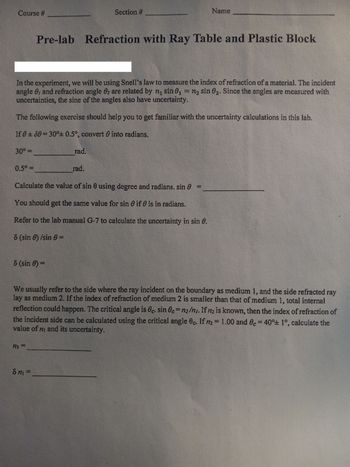In the experiment, we will be using Snell's law to measure the index of refraction of a material. The incident angle 8, and refraction angle 82 are related by n₁ sin 0₁ = n₂ sin 0₂. Since the angles are measured with uncertainties, the sine of the angles also have uncertainty. The following exercise should help you to get familiar with the uncertainty calculations in this lab. If 0+50=30°± 0.5°, convert 0 into radians. 30° = 0.5⁰ = rad. rad. Calculate the value of sin 8 using degree and radians. sin = You should get the same value for sin if is in radians.
In the experiment, we will be using Snell's law to measure the index of refraction of a material. The incident angle 8, and refraction angle 82 are related by n₁ sin 0₁ = n₂ sin 0₂. Since the angles are measured with uncertainties, the sine of the angles also have uncertainty. The following exercise should help you to get familiar with the uncertainty calculations in this lab. If 0+50=30°± 0.5°, convert 0 into radians. 30° = 0.5⁰ = rad. rad. Calculate the value of sin 8 using degree and radians. sin = You should get the same value for sin if is in radians.
Physics for Scientists and Engineers, Technology Update (No access codes included)
9th Edition
ISBN:9781305116399
Author:Raymond A. Serway, John W. Jewett
Publisher:Raymond A. Serway, John W. Jewett
Chapter3: Vectors
Section: Chapter Questions
Problem 3.61AP: Lei A = 60.0 cm at 270 measured from the horizontal. Let B = 80.0 cm at some angle . (a) Find the...
Related questions
Question
need help with this, thank you

Transcribed Image Text:Course #
30° =>
0.5⁰ =
In the experiment, we will be using Snell's law to measure the index of refraction of a material. The incident
angle, and refraction angle 82 are related by n₁ sin 0₁ = n₂ sin 02. Since the angles are measured with
uncertainties, the sine of the angles also have uncertainty.
The following exercise should help you to get familiar with the uncertainty calculations in this lab.
If 0±80=30°± 0.5°, convert 0 into radians.
8 (sin 8) =
Pre-lab Refraction with Ray Table and Plastic Block
n₁ =
Section #
rad.
Calculate the value of sin 0 using degree and radians. sin
You should get the same value for sin if is in radians.
Refer to the lab manual G-7 to calculate the uncertainty in sin 0.
8 (sin 0) /sin 0 =
d n₁ =
rad.
Name
We usually refer to the side where the ray incident on the boundary as medium 1, and the side refracted ray
lay as medium 2. If the index of refraction of medium 2 is smaller than that of medium 1, total internal
reflection could happen. The critical angle is 0c. sin Oc= n2/n. If n2 is known, then the index of refraction of
the incident side can be calculated using the critical angle 8c. If n2 = 1.00 and 8c = 40°± 1°, calculate the
value of n and its uncertainty.
Expert Solution
This question has been solved!
Explore an expertly crafted, step-by-step solution for a thorough understanding of key concepts.
Step by step
Solved in 3 steps

Follow-up Questions
Read through expert solutions to related follow-up questions below.
Follow-up Question
need the bottom part for n1 and difference of n1, thank you, show work please.

Transcribed Image Text:Course #
30° =
0.5⁰ =
In the experiment, we will be using Snell's law to measure the index of refraction of a material. The incident
angle 0, and refraction angle 02 are related by n₁ sin 0₁ = n₂ sin 02. Since the angles are measured with
uncertainties, the sine of the angles also have uncertainty.
The following exercise should help you to get familiar with the uncertainty calculations in this lab.
If 080=30°± 0.5°, convert 0 into radians.
8 (sin 8) =
Pre-lab Refraction with Ray Table and Plastic Block
n₁ =
Section #
rad.
Calculate the value of sin 0 using degree and radians. sin =
You should get the same value for sin if is in radians.
Refer to the lab manual G-7 to calculate the uncertainty in sin 8.
8 (sin 0) /sin =
d m₁ =
rad.
Name
We usually refer to the side where the ray incident on the boundary as medium 1, and the side refracted ray
lay as medium 2. If the index of refraction of medium 2 is smaller than that of medium 1, total internal
reflection could happen. The critical angle is 0c. sin 0c-n₂/n. If n₂ is known, then the index of refraction of
the incident side can be calculated using the critical angle 8c. If n2 = 1.00 and 0c = 40°± 1°, calculate the
value of n and its uncertainty.
Solution
Knowledge Booster
Learn more about
Need a deep-dive on the concept behind this application? Look no further. Learn more about this topic, physics and related others by exploring similar questions and additional content below.Recommended textbooks for you

Physics for Scientists and Engineers, Technology …
Physics
ISBN:
9781305116399
Author:
Raymond A. Serway, John W. Jewett
Publisher:
Cengage Learning

University Physics Volume 3
Physics
ISBN:
9781938168185
Author:
William Moebs, Jeff Sanny
Publisher:
OpenStax

Physics for Scientists and Engineers, Technology …
Physics
ISBN:
9781305116399
Author:
Raymond A. Serway, John W. Jewett
Publisher:
Cengage Learning

University Physics Volume 3
Physics
ISBN:
9781938168185
Author:
William Moebs, Jeff Sanny
Publisher:
OpenStax